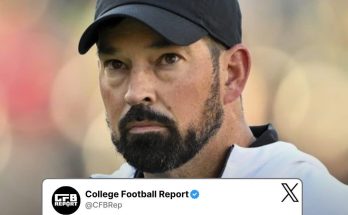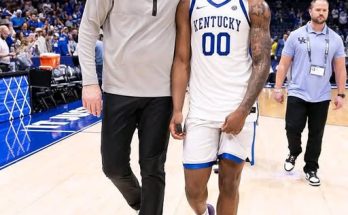In the world of sports media, there are few voices as brash, unapologetic, and polarizing as Dave Portnoy. The founder of Barstool Sports, Portnoy has long made a name for himself by pushing the envelope, engaging in tribal sports feuds, and unapologetically waving the banner for his beloved Michigan Wolverines. He’s as much a provocateur as he is a media mogul, and once again, he’s found himself at the center of a heated college football debate—this time, by throwing major shade at the Ohio State Buckeyes amid swirling rumors about the Big Noon Kickoff scheduling controversy.
The backdrop for this recent spat lies in the complex and often murky world of college football media rights, broadcasting schedules, and the intense rivalry between Michigan and Ohio State. While the game itself remains a sacred tradition, the off-field antics and media maneuvering have added new layers to the rivalry in the digital age. With Fox Sports’ Big Noon Kickoff emerging as one of the most influential media slots in college football, the fight over which teams get featured and when has become just as contested as the games themselves. Enter Dave Portnoy, who took to social media recently to mock Ohio State fans and administrators over rumors that the Buckeyes were unhappy with potential scheduling implications that could negatively affect them. He didn’t hold back.
According to Portnoy, Ohio State was allegedly pushing back against the idea of their big rivalry game with Michigan being held at noon, which is Fox’s prime slot. This came after years of Michigan embracing the noon start, not just for tradition but also for branding purposes. Portnoy spun this into an opportunity to paint Ohio State as weak, entitled, and insecure—a narrative that plays directly into the classic Michigan versus Ohio State dichotomy of self-perception and public projection.
It’s important to understand that the Big Noon Kickoff has become a serious component of the college football media ecosystem. When Fox acquired major rights deals to air Big Ten games, they reshaped the landscape by making noon ET their flagship time slot, often placing the marquee Big Ten matchup of the week in that window. While traditionalists have sometimes balked at the early kickoff times—especially fans on the West Coast or those who prefer prime time atmospheres—Fox has defended the decision by citing viewership numbers and advertiser interest. Michigan has thrived in that format, often embracing the noon kickoff as a badge of honor. Ohio State, however, has not always shared that sentiment.
This difference in attitude between the two schools became a perfect opportunity for Portnoy to needle Ohio State fans. He mocked them for allegedly trying to change the game time to later in the day, suggesting it was a sign of weakness and lack of confidence. “Imagine needing darkness to compete,” Portnoy tweeted, followed by a meme of a Buckeye fan crying into a pillow. For Michigan fans, it was classic Portnoy—blunt, harsh, and utterly partisan. But for Ohio State fans, it was yet another example of why Portnoy represents everything wrong with media personalities who blend fandom with influence.
The real issue beneath Portnoy’s antics is a broader discussion about how media, money, and tradition intersect in today’s college football. The Michigan-Ohio State rivalry, known simply as “The Game,” is arguably the most storied rivalry in all of college football, if not all of American sports. Its history spans generations, shaped by epic battles, coaching legends, and national title implications. For decades, the game has traditionally been played at noon, typically on the last Saturday of the regular season. That consistency has become part of its identity.
However, the rise of cable networks, streaming platforms, and ratings wars has placed new pressures on when and how games are scheduled. Prime time slots are lucrative, drawing more viewers and higher ad revenue. While Fox has doubled down on noon kickoffs as their marquee platform, other networks like ESPN and ABC have often lobbied for evening matchups. In this environment, every scheduling decision becomes a negotiation between TV executives, athletic departments, and, increasingly, vocal fan bases and influencers.
Portnoy’s comments, while designed to be inflammatory, actually illuminate how much the Michigan-Ohio State rivalry has evolved in the modern era. It’s no longer just about the game—it’s about the narratives surrounding the game, the media platforms hyping it, and the personalities shaping public perception. In that regard, Portnoy is a master manipulator. He understands that in today’s attention economy, sports is just as much about engagement and outrage as it is about stats and wins. By ridiculing Ohio State and implying that they can’t handle the heat of a noon kickoff, he’s adding fuel to an already scorching rivalry.
There’s also a cultural element to this feud that shouldn’t be ignored. Michigan fans, particularly those aligned with Portnoy’s online persona, often see themselves as intellectual, historically superior, and rooted in tradition. Ohio State fans, on the other hand, take pride in their gritty, working-class ethos and no-nonsense football dominance. When Portnoy mocks Ohio State for complaining about a noon kickoff, he’s not just talking about TV slots—he’s suggesting that the Buckeyes are soft, entitled, and not up to the challenge. That kind of commentary cuts deep, because it challenges the very identity of Ohio State football.
To Ohio State supporters, Portnoy’s attacks are doubly insulting because they come at a time when the Buckeyes are trying to regain their footing in the rivalry. Michigan has won the last three meetings between the two teams, flipping the script after nearly two decades of Ohio State dominance. Each loss has been more painful than the last for Buckeye Nation, and the momentum now clearly resides in Ann Arbor. Portnoy, never one to miss an opportunity to kick a rival while they’re down, has made it his mission to remind Ohio State fans of their recent failures.
That kind of trolling may seem juvenile to some, but it’s part of a broader media strategy. Portnoy isn’t just a fan—he’s a brand. His public feuds with other fan bases drive traffic, clicks, and engagement for Barstool Sports. Every tweet, every Instagram story, every podcast rant serves a dual purpose: rile up the rival fan base and reinforce his brand as Michigan’s loudest supporter. In that context, his recent shade toward Ohio State over the Big Noon rumors is as much a business move as it is a personal jab.
Still, the optics of the situation can be frustrating for college football traditionalists. What was once a proud, respectful rivalry based on performance and legacy is now increasingly shaped by online personalities and media theatrics. There’s a fine line between passionate fandom and toxic provocation, and Portnoy often dances on that line. For those who grew up watching “The Game” with reverence, his antics can feel like a mockery of something sacred.
But like it or not, this is the new reality of college football. Media figures like Portnoy have become part of the ecosystem, influencing not just fan conversations but potentially even administrative decisions. If enough fans protest or celebrate a decision loudly enough on social media, universities and networks take notice. In that sense, Portnoy’s ridicule of Ohio State isn’t just entertainment—it’s part of a feedback loop that can shape real-world outcomes.
It’s also worth noting that Portnoy isn’t the only one stirring the pot. Ohio State fans have their own share of outspoken media personalities and influencers who take shots at Michigan. The back-and-forth is constant, and it reflects the intensity of the rivalry. However, Portnoy stands apart because of his platform and visibility. With millions of followers and a reputation for controversy, his words carry weight—even when they’re dripping with sarcasm and hyperbole.
In the end, the Michigan-Ohio State rivalry will always be defined by what happens on the field. No amount of online trash talk can replace the drama of fourth-quarter heroics or goal-line stands. But in today’s media-driven sports culture, voices like Portnoy’s have carved out a new kind of influence—one that extends beyond the scoreboard and into the hearts, minds, and timelines of fans everywhere.
So whether you find his comments hilarious or offensive, dismissive or dead-on, one thing is clear: Dave Portnoy knows exactly what he’s doing. By throwing shade at Ohio State over Big Noon rumors, he’s asserting Michigan dominance not just on the field but in the cultural conversation surrounding college football. He’s making sure that when fans argue about kickoff times, media contracts, and rivalry lore, his voice is part of the narrative.
And perhaps that’s the biggest lesson from this saga—not just about college football rivalries, but about how media shapes modern sports. In an age where influencers can move the needle, fans must learn to separate noise from nuance. Portnoy may be a self-proclaimed “clown,” but he’s also a master of the game. The question is whether fans—and schools—will continue to play along.



